#209: Gyromitra caroliniana, Big Red
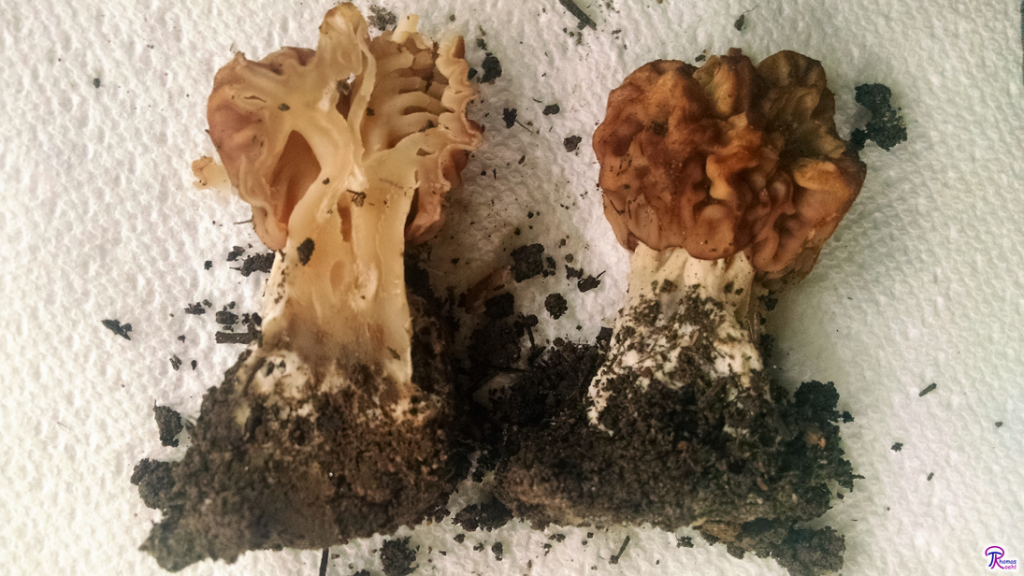
Gyromitra caroliniana is a false morel known as “Big Red” because of its reddish cap and because it grows very large.
Gyromitra caroliniana, variously called the “Red False Morel,” “Carolina False Morel,” or – my personal favorite – “Big Red,” is a false morel (see FFF#034) that can grow to astounding sizes. It has a reddish-brown cap that is tightly wrinkled, making it look very similar to true morels (see FFF#033). The easiest way to differentiate Big Red from true morels is to cut it in half; true morels have a central hollow chamber while false morels like Big Red are solid or have lots of small chambers. Big Red gets its common name from its cap color and the fact that it routinely produces mushrooms that weigh over three pounds.1,2
Description
Like most ascomycete mushrooms, G. caroliniana is divided into two parts: a head and a stipe. The head is reddish-brown and features deep irregular wrinkles. It can grow 5-11cm tall and 6-12cm wide, although the largest specimens get much bigger. G. caroliniana specimens larger than three pounds appear routinely and at least one mushroom was found that weighed over 20 pounds! The head is mostly roundish but can become somewhat irregular in larger mushrooms.1
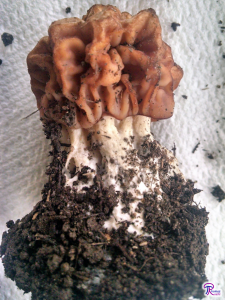
The tight and deep wrinkles on the head of G. caroliniana help to distinguish it from other false morels.
There are a few key points on the head that differentiate Big Red from other false morels: the head his attached tightly to the tissue underneath, very little of the head tissue hangs down over the stipe, the head is not divided into noticeable lobes, and the head forms deep and tight wrinkles. This last factor is probably the most helpful. Other false morels have wrinkles that are close together and shallow or are deep and far apart, but none (in North America, at any rate) are quite like G. caroliniana. In fact, Big Red’s wrinkles are more similar in shape to those of true morels than to those of other false morels.1,3
The stipe is white, vertically wrinkled, and gets larger toward the base. This shape is actually very similar to the base of a large tree. In most specimens, the stipe grows 4-10cm tall and 2-10cm wide, making it much stockier than that of other false morels. The stipe can get much larger than 10cm, but its structure remains essentially the same.1
Cut the mushroom in half to reveal its white flesh is divided into many small chambers. This reminds me of a sponge, although Big Red’s air bubbles are vertically elongated and twisted into irregular shapes. Along the top edges where the interior flesh connects to the head, the flesh splits into tree-like branches and attaches to the head at multiple points.1
The stipe interior is an important factor to assess when deciding if you’ve found a true morel or a false morel. False morels have a solid but chambered stipe, as described above, while true morels are hollow. When sliced in half, true morels resemble the outline of an elongated lava lamp because of their single hollow chamber that extends from the base to the top of the head.2
You can also use the interior flesh to help differentiate between false morel species. Many false morels attach to the head only at the very top, but G. caroliniana attaches at multiple points for most of the head’s length. This keeps the head tight against the stipe, while other species of Gyromitra have heads that are skirt-like and can feature significant gaps between the stipe and the bottom of the head.3,4
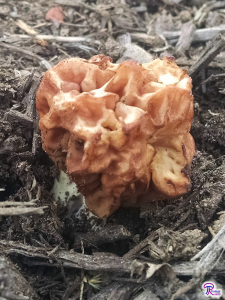
This specimen of G. caroliniana growing in mulch demonstrates the mushroom’s primary ecological role, as a decomposer.
Ecology
There is some question about what exactly G. caroliniana does. The fungus is presumably saprobic, but it sometimes appears to behave like a mycorrhizal fungus. Perhaps it does different things depending upon what resources are available or depending on the stage in its life cycle.1 The first G. caroliniana I found was in a bed of mulch with only a few shrubs nearby (and based on historical images from Google Earth, there hasn’t been a tree there for at least ten years and probably for over twenty years). This indicates the mushroom is capable of completing its life cycle entirely as a saprobe.
In North America, Big Red’s range is limited to the eastern United States, from Kansas eastward and from the Great Lakes southward. However, the mushroom is most plentiful in the southeast and near the Mississippi and Ohio rivers. G. caroliniana appears under hardwoods, usually next to dead trees, in the spring and summer.1
Similar Species
Big Red is the false morel that is easiest to confuse with true morels; both G. caroliniana and true morels have deep tight wrinkles. Of course, you can easily differentiate between the two by cutting your mushroom in half. True morels are hollow on the inside and their heads attach to the interior flesh seamlessly.2 Actually, if you’ve seen enough true morels you should have no problem distinguishing G. caroliniana. Big Red’s folds are just slightly more irregular with more uniform colors.
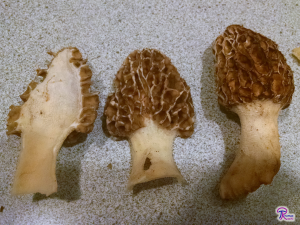
True morels, such as the ones above, are hollow and have heads that seamlessly attach to the interior flesh. This makes them easy to differentiate from false morels once sliced in half.
In North America, the two species of Gyromitra that are most likely to be confused with G. caroliniana are G. brunnea and G. korfii.3 G. brunnea has thin wrinkles and its tan to red-brown head is usually divided into distinct lobes. The outer edges of the lobes often extend far away from the stipe while the inner folds of the lobes are directly attached to the stipe.4 G. korfii (and its western counterpart G. montana) has a squarish tan to brown head with thin wrinkles. It is sometimes divided into lobes, but the head is usually closely attached to the stipe.5
Edibility
Big Red’s edibility is probably best described as “uncertain.” The general advice is to never eat any species of Gyromitra, since those mushrooms all potentially contain gyromitrin (see FFF#092), which breaks down in the body to become the toxin monomethylhydrazine (MMH).2,6 Some people do eat false morels without getting sick, but the mushrooms must be thoroughly parboiled to remove all the toxins. However, parboiling releases the toxins into the air, so you can still get sick by breathing in the steam from the cooking mushrooms.2 As I see it, false morels are too risky, require too much preparation, and have too bland of a flavor to bother eating them.
G. caroliniana seems to contain less gyromitrin than most false morels.2 So, if you are going to experiment with eating false morels, I would suggest starting with Big Red. Just keep in mind that you need to thoroughly cook them and eat only small portions to help reduce the poisoning risk.2,7 Also, be aware of poisoning symptoms in case you were unsuccessful at removing all the toxins.
Symptoms of MMH poisoning appear after 6-12 hours and include the standard nausea, vomiting, and diarrhea but also include weakness, a lack of energy, and headache. In severe cases, MMH can harm the liver and central nervous system, resulting in jaundice and convulsions. Untreated severe cases are potentially fatal.2
Taxonomy
G. caroliniana belongs to the genus Gyromitra, which includes all other false morels. Gyromitra also has other morphological types, including cup fungi and elfin saddles. True morels belong to the same order as Gyromitra – Pezizales – but belong to a different family.8
| Kingdom | Fungi |
| Division (Phylum) | Ascomycota |
| Subdivision (Subphylum) | Pezizomycotina |
| Class | Pezizomycetes |
| Subclass | Pezizomycetidae |
| Order | Pezizales |
| Family | Discinaceae |
| Genus | Gyromitra |
| Species | Gyromitra caroliniana (Bosc) Fr.9 |
This post does not contain enough information to positively identify any mushroom. When collecting for the table, always use a local field guide to identify your mushrooms down to species. If you need a quality, free field guide to North American mushrooms, I recommend Michael Kuo’s MushroomExpert.com. Remember: when in doubt, throw it out!
See Further:
http://www.mushroomexpert.com/gyromitra_caroliniana.html
http://botit.botany.wisc.edu/toms_fungi/may2002.html
https://ohiomushroomsociety.wordpress.com/2013/02/25/false-morels/
http://missourimorels.blogspot.com/2009/03/debate-over-reds-to-eat-or-not-to-eat.html
Citations
- Kuo, M. Gyromitra caroliniana. MushroomExpert.Com (2012). Available at: http://www.mushroomexpert.com/gyromitra_caroliniana.html. (Accessed: 31st March 2018)
- Volk, T. J. Tom Volk’s Fungus of the Month for May 2002. Tom Volk’s Fungi (2002). Available at: http://botit.botany.wisc.edu/toms_fungi/may2002.html. (Accessed: 31st March 2018)
- Kuo, M. Gyromitra: The False Morels. MushroomExpert.Com (2012). Available at: http://www.mushroomexpert.com/gyromitra.html. (Accessed: 31st March 2018)
- Kuo, M. Gyromitra brunnea. MushroomExpert.Com (2012). Available at: http://www.mushroomexpert.com/gyromitra_brunnea.html. (Accessed: 31st March 2018)
- Kuo, M. Gyromitra korfii. MushroomExpert.Com (2012). Available at: http://www.mushroomexpert.com/gyromitra_korfii.html. (Accessed: 31st March 2018)
- Sturgeon, W. False Morels. Ohio Mushroom Society (2013).
- Ahistory. Mid Missouri Morels and Mushrooms: The Debate over Reds – To Eat or Not to Eat. Mid Missouri Morels and Mushrooms (2009).
- Kuo, M. Mushroom Taxonomy. MushroomExpert.Com (2014). Available at: http://www.mushroomexpert.com/taxonomy.html. (Accessed: 31st March 2018)
- Gyromitra caroliniana. Mycobank Available at: http://www.mycobank.org/Biolomics.aspx?Table=Mycobank&Rec=345140&Fields=All. (Accessed: 31st March 2018)

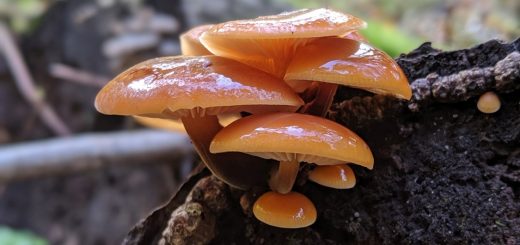






![#011: Characteristics of Kingdom Fungi [Archived]](https://www.fungusfactfriday.com/wp-content/themes/hueman/assets/front/img/thumb-small-empty.png)

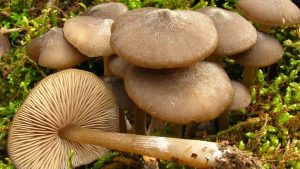
Might be time to revisit the subject of G.caroliniana’s edibility. There are actually NO reports of poisoning from this species (although some people have a sensitivity to them, just like with morels, for example). There’s no proof that these contain any gyromitrin at all. Here’s a good article about them:
https://www.fungimag.com/spring-2014-articles-02/V7I1%20LR%20FalseMorels28-31pdf.pdf
I’ve grown up eating the Carolinana variety never parbold them only soak them saltwater for 12 hours rinsed them and repeated with fresh water for another 6 hours then rinsed them flowered and deep fried then salt and pepper and I have eaten these mushrooms since I was 5 years old I am 30 years old now and I still continue to harvest these mushrooms and never have gotten sick ever and I’ve eaten whole platefuls of these at a time they are quite filling not bland tasting they’re actually more flavorful then actual morels when prepared like thisif they haven’t been soaking long enough in a saltwater brine they will have a woody bitter taste but will not have any bitter taste when properly done and if you want to make sure for safety you can do the salt water peried Twice for a total of 24 hours soaking in saltwater brine and the water will become a deep dark red color but not blood red about the same color red as the flesh of the cap